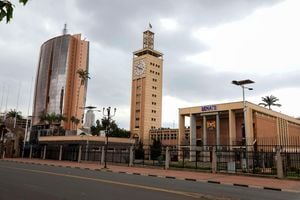Where persons with diabetes receive care that goes beyond treating symptoms, affordably
Sponsored by Lions SightFirst Eye Hospital

Lions Diabetes Care Centre in Nairobi.
By Millicent Mwololo
The Lions SightFirst Eye Hospital has combined affordable services, advanced technology, and support systems to manage diabetes effectively and improve the quality of life of patients. This is at the specialised Lions Diabetes Care Centre.
The hospital leverages technology, including a telemedicine app where patients can book appointments and access monitoring. "When I put my timings in the app-based telemedicine platform, patients see my availability and book appointments, and I then get a notification that I have an appointment with patient X at such a time," explains Dr Rilwan Adan, the Head of Lions Diabetes Care Centre.
Remotely, doctors are able to monitor the progress of patients. "If we feel that any of our patients needs to come in because of their blood sugar levels, we inform them," adds Dr Rilwan.
The facility also does telemonitoring through a continuous glucose monitoring (CGM) machine. “I can monitor my patients’ blood sugar levels remotely,” Dr Rilwan says confidently. “For example, if I can see that one of my patients consistently has high sugar levels in the afternoon, I can then ask about their meals and snacks between 12pm and 8pm. With that insight, we can work on adjusting their lifestyle rather than increasing their medication unnecessarily.”

Dr Rilwan Adan, the Head of Lions Diabetes Care Centre.
The CGM is a game-changer in diabetes management and care. It is improving the quality of life of persons with diabetes. Patients don’t have that fear of ‘my sugar is going to go down’. They can see its levels.
This approach helps tailor patient lifestyle changes without unnecessarily adjusting medications. At Ksh10,000 per unit, CGM is accessible to many patients, providing real-time alerts and reducing anxiety about blood sugar fluctuations.
Also, the worry that children with diabetes can sleep through low sugar and get into a coma is reduced because CGM sends an alert when the sugar level goes down.
CGM has significantly enhanced lifestyle management for patients. It allows them to track their blood sugar levels throughout the day and identify which foods cause spikes. With this information, they can make informed choices about their diet. They also learn that exercising at specific times can help lower their sugar levels to a certain range.
CGM therefore empowers patients to take control of managing their blood sugar. “When patients first come to us, they often feel it’s up to us, the doctors, to handle everything. But with CGM, they gain the confidence to manage their levels independently,” Dr Rilwan says.
For those who cannot afford the machine, Dr Rilwan recommends regular self-monitoring at home. “Diabetes patients live with this condition every day, so self-management and understanding are critical,” she notes.
Treatment is highly subsidised at the Lions Diabetes Care Centre. The facility offers a consultation fee of Ksh1,500 and affordable laboratory services compared to standard private hospitals. “We partner with organisations to access quality medications because we are a charitable institution,” she explains. This helps provide affordable, high-quality medication for conditions like hypertension and diabetes, although some prices remain subject to market rates.

A continuous glucose monitoring device.
The Centre’s comprehensive approach encompasses diabetes screenings, checks for complications, and a strong focus on preventive care. As a tertiary eye hospital, Lions SightFirst Hospital primarily receives patients who have already developed complications, with retinopathy being the most prevalent. Retinopathy, a form of eye damage caused by diabetes, occurs when small blood vessels in the retina are damaged. It is now becoming the leading cause of blindness globally.
Dr Rilwan says when such tiny vessels are harmed in the eye, similar damage often affects vessels in other organs, like the kidneys. By the time eye damage appears, kidney damage may also be underway. “We have specialised tests to detect kidney issues before they cause functional loss. Every year, we screen individuals with diabetes, regardless of whether they show eye complications, to monitor their eyesight and kidney health,” she adds.
In addition to small vessels, nerves are also impacted. When nerve damage occurs, patients may develop diabetic foot complications. To address this, Lions has established a specialised diabetic foot clinic to prevent amputations.
Explains Dr Rilwan: "Diabetes complications can lead to severe disabilities, including blindness and amputations. So we aim to intervene early to prevent them. In the foot clinic, patients are provided with custom-designed footwear, such as foot wear and special orthotics. The foot is carefully assessed to determine the appropriate footwear, which helps reduce pressure on sensitive areas and protect nerves.
“If a patient has a callus, their footwear is crafted to relieve pressure from that spot. If they have a wound, they need to avoid using that part of the foot when walking.”
Heart disease is the leading cause of death among diabetes patients due to complications. At the clinic, patients get annual screenings for heart conditions. “Heart failure, for example, develops gradually rather than suddenly, and we also screen for conditions like heart attacks and strokes,” says the doctor.
Obesity is an escalating problem in Kenya, warns Dr Rilwan. “Waist sizes are increasing, even in younger populations, and soon we may start seeing Type 2 diabetes onset in teenagers.” Globally, the onset age for Type 2 diabetes has been steadily decreasing. This, she notes, is highly attributed to sedentary lifestyles. “We are walking less and we are eating more of junk food. Our diet is predominantly carbohydrate-loaded diet, and not forgetting that stress levels are increasing every day. Combining all these, the incidence of diabetes goes up.”
Obesity combined with diabetes makes one experience diabetes complications much faster. Obesity alone without diabetes can lead to heart disease, kidney damage, joint arthritis, and obstructive sleep apnea (loss of sleep at night). The prevention of obesity is mainly lifestyle – exercising and watching diet. “Obesity is not only a risk factor for developing diabetes conditions, but is now being recognised as a chronic condition. With science, there are therapies.”
At the clinic, patients access weight loss therapies, with the guidance of a doctor and complement it with an in-house nutritionist who prepares individualised meal plans. “We have had patients who have achieved target weight.” Once these patients lose weight, she explains, they tend to have diabetes remission and stop using medication because their blood sugar has fallen within the normal range.
“There is a parameter we check in the lab, hemoglobin A1C (HbA1C) test which shows a patient’s average blood sugar for three months. When HbA1C is within normal range for one year, this patient is said to be in remission. The drugs dosage is then reduced over time before it is withdrawn,” she explains.
Type 2 diabetes – up to 90 percent – is hereditary and runs in the family. But there is also epigenetics whereby genes can change depending on the environment one has been living in.
When a diabetes patient comes to the centre for the first time, the doctor does comprehensive review and physical examination of the patient, sends them for investigations to confirm diagnosis, and screen for complications. The doctor gives an individualised treatment plan, and thereafter, sends the patient to the nutritionist for an individualised meal plan.
There is also a diabetes educator who disseminates knowledge to enhance self-management of patients. Patients are also educated on signs to monitor, which help them recognise when their blood sugar may be too low or too high.
“Our diabetes educators maintain 24-hour contact with patients on insulin, providing continuous support, a complimentary service we offer to help manage their condition.”
Dr Rilwan coordinates the support group, which meets monthly. This has enhanced the quality of life for patients.
“Our clinics approach to diabetes management is built around comprehensive, patient-centred care that goes beyond treating symptoms to addressing the whole person. Through technology, personalised treatment plans, lifestyle guidance, and continuous support, we strive to empower each patient in their journey towards better health. Our focus remains on creating support environments where patients feel heard, equipped and motivated to manage diabetes effectively,” says Dr Rilwan.


